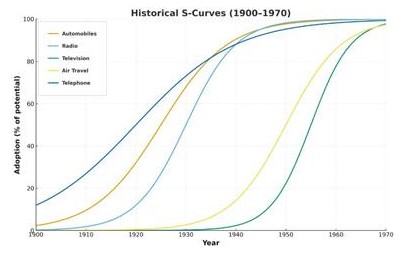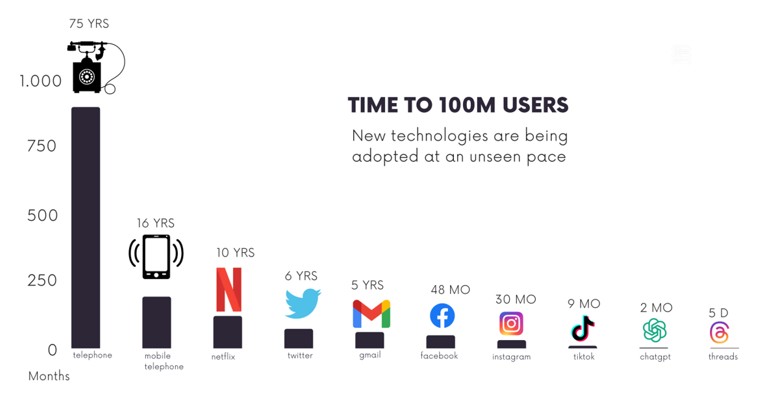Colliding S-Curves: How Community Colleges Navigate the Next Wave of Change
S-Curves - Week 1
By Rick Aman onWeek 1 | Understanding Colliding S-Curves — The Shape of Change
Why every college leader needs to recognize the pattern of disruption before it arrives.
Introduction — Seeing the Pattern Before the Pivot
Experience has taught me that disruption rarely announces itself with fanfare. It builds quietly beneath our feet, forming a new curve of growth just as the old one begins to flatten. One semester a program is thriving; the next, it’s stagnant while something entirely new begins to accelerate elsewhere. Leadership today demands that we see those patterns before the pivot.
The S-curve has long been used to describe this process. Every innovation, whether electricity, telephone, automobile, or personal computers follows a similar trajectory: slow adoption, rapid acceleration, and eventual maturity. The insight is simple yet profound: growth is never infinite. Each curve levels off, and another inevitably begins. Consider that when the automobile overtook the horse-drawn carriage, one curve rose as the other faded, progress that felt magical to some and intimidating to others. For most of higher-education history, we faced only one or two S-curves at a time. There was time to adjust. Change came sequentially. Today, however, we are witnessing colliding S-curves, multiple waves of innovation and social change rising simultaneously and intersecting unpredictably.
Arthur C. Clarke once said, “Any sufficiently advanced technology is indistinguishable from magic.”
To many presidents, boards and executive teams, AI already feels like that kind of magic, both wondrous and unsettling. The challenge for community college leaders is not simply to watch the show, but to learn the science behind it to understand how to read the curves before they collide. I would like to spend the next few weeks exploring the magic of S-Curves, their value to colleges in predicting themes and trends, but mostly to help project organizations into a preferred future which uses these innovations as tools.
The Original S-Curve: Innovation, Maturity, and Renewal
The classic S-curve represents the life cycle of any idea or industry. It begins slowly, accelerates as adoption grows, and finally matures before decline. Each new curve builds on the one before it.
 Previous bodies of research always become the basis for fresh thinking at the fringe. That insight captures why innovation is rarely born in isolation. What’s mainstream today started years ago on the edge of someone’s imagination.
Previous bodies of research always become the basis for fresh thinking at the fringe. That insight captures why innovation is rarely born in isolation. What’s mainstream today started years ago on the edge of someone’s imagination.
American colleges have lived this pattern repeatedly. The post-WWII access revolution was one curve with veterans returning home, the GI Bill fueling growth, campuses springing up in every region. A generation later, workforce programs and applied-technology degrees caused the emergence of community colleges, marked another steep ascent as industry demanded skilled technicians. The rise of online learning formed the next curve, expanding access and redefining delivery. That movement, accelerated by the COVID-19 pandemic, pushed colleges to adopt digital, hybrid, and flexible models at scale transforming what began as an experiment in distance learning into a permanent dimension of higher education.
Leaders who anticipate the next inflection point don’t abandon success; they extend it. Every success carries the seed of its own decline. The question isn’t whether a curve will flatten, it’s whether we’ll recognize the inflection point early enough to prepare for the next ascent.
When Curves Collide: Exponential Growth and the Speed of Adoption
In earlier decades, the time between curves gave institutions breathing room. The adoption of electricity, radio, and television spanned generations. Strategy could evolve slowly. Not anymore. Consider how quickly new technologies reach a baseline of 100 million users:

Telephone: 75 years
Television: 50 years
Internet: 7 years
Instagram: 2 years
ChatGPT: 2 months
In the twentieth century, society was shaped by only one or two dominant S-curves at a time. The industrial economy unfolded through electricity, automobiles, and radio, each building upon the last.
Today, we face multiple transformative drivers converging at once:
Artificial Intelligence & Automation — redefining work, learning, and the skills required to thrive
Demographic Decline — shrinking youth cohorts and an aging workforce reshaping labor markets
Digital Infrastructure — expanding cloud computing, broadband access, and cybersecurity needs
Energy Transition — building entirely new workforce pipelines to power a sustainable economy
Public Trust & Value Perception — questioning the cost, relevance, and return on higher education
When curves collide, volatility spikes, but so does opportunity. Early adopters gain disproportionate advantage. As Wayne Gretzky advised, “Skate to where the puck will be.” For college leaders, that means positioning programs, partnerships, and budgets not for today’s demand curve, but for the next one forming just ahead.
Forecasting isn’t fortune-telling; it’s pattern recognition. By studying trends, leaders can glimpse where momentum is built and allocate resources accordingly. The advantage of forecasting the future is simple: organizations that see trends early can prepare to take advantage of them.
Futuring invites leaders to think beyond immediate pressures. It asks, what developments at the edge might soon reshape our core? Sometimes those signals appear in unrelated industries, a new technology in logistics that later transforms manufacturing, or an AI innovation in healthcare that soon affects education. Trends and themes help shape the broader context of a region or sector by revealing how developments in seemingly unconnected fields will affect us all.
When I work with boards today, I remind them that the goal of futuring isn’t to predict which technology will win. It’s to cultivate awareness, to create the capacity to notice when the next curve begins to bend upward. Because once exponential growth starts, catching up is nearly impossible.
Why Community Colleges Are the First Responders
Community colleges have long been the nation’s shock absorbers in times of change. When industries collapse, we retrain the workforce. When technology advances, we translate complexity into curriculum. When economic shocks hit, our doors open wider. Community Colleges tend to be counter cyclical in times of unemployment.
That agility positions us uniquely to navigate colliding S-curves, but only if we pair responsiveness with foresight. Rapid adaptation without direction can lead to mission drift; foresight turns reaction into strategy. Forecasting helps colleges anticipate trends. It enables boards and presidents to ask forward-leaning questions:
What are the emerging industries our region doesn’t yet recognize?
Which of our programs are approaching maturity and which are climbing?
How might AI or demographic change alter the very definition of student success?
By asking these questions early, leaders create strategic margin the time and flexibility to act before necessity forces reaction. Our proximity to local communities gives us another advantage: we hear signals early. Employers mention new technologies before they hit headlines. Adult learners inquire about credentials that don’t yet exist. Civic leaders discuss workforce gaps that data won’t reveal for another year. Those whispers are the leading edge of the next curve. Still, awareness must be intentional. Futuring isn’t a luxury it’s a discipline.
Summary and Application — Awareness Before Action
The S-curve teaches that progress is cyclical: growth, maturity, renewal. What’s different today is both the speed and the convergence of change. Multiple curves are rising and intersecting at once, creating what I call the collision zone, a place of risk for those unprepared, but of reinvention for those who see it early.
For community colleges, understanding these curves is more than theory, it’s a survival strategy. The institutions that thrive will be those that recognize the early signals of new demand, adapt their programs accordingly, and align mission with movement.
These ideas capture the essence of futuring in higher education: to make sense of innovations before they overwhelm us and to position ourselves where the next opportunity will emerge. Awareness precedes readiness. Readiness produces resilience. And resilience will define the next generation of financially sustainable community colleges.
-----
At Aman & Associates, we help presidents, boards and executive teams develop foresight capacity to anticipate emerging S-curves, integrate futuring into strategy, and align decisions with mission and regional relevance. If your organization is ready to look beyond today’s horizon, I’d welcome the conversation.
Rick Aman, PhD - Aman & Associates
rickaman.com/articles
© 2025 Aman & Associates. All rights reserved
